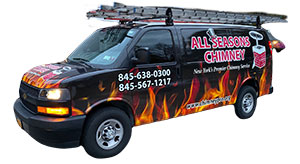Weather experts have predicted the upcoming winter to be as brutal as the previous year, which means everyone should start preparing now. For many homeowners in the Hudson Valley area, staying warm might involve lighting a fire in the fireplace or stove, and this type of heating requires special care and attention to ensure a safe winter season. Chimney specialists recommend having a chimney sweep and inspection done annually. The sweep cleans out any obstructions and creosote buildup, while the inspection uncovers any safety or structural issues in the chimney, like a missing or non-insulated chimney liner.
First and foremost, having a liner inside the chimney is crucial for keeping the house protected against the heat of the fire, whether it burns wood or gas. In a study done by the National Bureau of Standards, a fire burning beneath an unlined chimney resulted in the adjacent woodwork catching fire in less than four hours. Essentially, one evening of enjoying a warm, crackling fire could end in a disastrous house fire if the chimney has no liner.
While having a chimney liner does provide a measure of protection, taking one more step and insulating the liner offers even more benefits. In fact, insulating the chimney may be necessary for safety reasons, especially if the clearance to combustibles cannot be determined. The clearance to combustibles refers to the proper distance from the chimney liner to the flammable construction materials used to build the home to avoid an unintentional fire. If the chimney’s structure prohibits this distance from being determined, the safest option is to assume the liner and combustibles are too close together and to insulate the liner as protection. The insulation prevents the extremely hot liner from resting on or sitting too closely to any wood, drywall or plaster and causing a fire.
Another major advantage to an insulated liner is that it maintains a warmer temperature inside the chimney. In particular, exterior chimneys that have at least one side exposed to the elements benefit from this because the cold temperatures do not have such a drastic effect on the chimney temperature. The same goes for portions of the chimney that extend above the roofline, where the entire chimney feels the cold weather. When chilly temperatures are allowed to cool down the interior of the chimney, the smoke products of the fire also cool down and condense onto the inside of the chimney. For wood-burning appliances, this condensation involves thick, tarry creosote, which increases the risk of an unintentional chimney or house fire.
A warm, insulated chimney also means the fire burns more efficiently. None of the energy from the fire is wasted on warming up the chimney and creating the initial draft. Instead, the fire can start hot and burn for a longer amount of time, which ultimately saves money in fuel efficiency.
To determine if your chimney has an insulated liner or to have an insulated liner installed, get in touch with your local chimney expert. For those living in the lower Hudson Valley area, contact All Seasons Chimney for a professional consultation.


